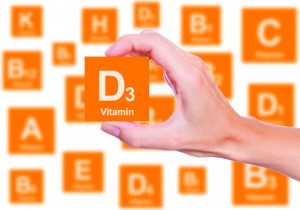Mitchell J. Ghen, D.O., Ph.D.
 Whoever thought the vitamin considered to be the one to stop rickets would then be reclassified in our lifetime as no longer a vitamin but instead a hormone? Vitamin D is a hormone that is involved in more than 300 reactions per second in the human body. For the most part vitamins need to be taken as cofactors for multiple reactions in our human chemistry. Unlike others, Vitamin D can be synthesized by the human body. Incredibly, exposure of sun to the oils in our skin can convert these oils to their active form of Vitamin D. Vitamin D is classified as a fat-soluble vitamin along with vitamins K,E and A. For that reason it can be stored by the body and therefore, at certain levels, can become toxic.
Whoever thought the vitamin considered to be the one to stop rickets would then be reclassified in our lifetime as no longer a vitamin but instead a hormone? Vitamin D is a hormone that is involved in more than 300 reactions per second in the human body. For the most part vitamins need to be taken as cofactors for multiple reactions in our human chemistry. Unlike others, Vitamin D can be synthesized by the human body. Incredibly, exposure of sun to the oils in our skin can convert these oils to their active form of Vitamin D. Vitamin D is classified as a fat-soluble vitamin along with vitamins K,E and A. For that reason it can be stored by the body and therefore, at certain levels, can become toxic.
Up until recently most would’ve considered Vitamin D in very low doses and only for the prevention of rickets and perhaps the absorption or enhanced absorption of calcium. However, during the past year alone, hundreds of articles written about Vitamin D, and its usefulness in so many diseases, make a compelling argument for its use in everyone from infancy to the elderly. Doses much higher than originally thought are needed to create the elevated optimal levels for human nutrition. Currently, the normal level given by labs for Vitamin D3 is 30-100 ng/mL, however, the optimal level that should be strived for are between 60-100 ng/ml. At this optimal range a decrease and protection from significant diseases that beset humankind are suggested. There are two major forms of Vitamin D: Ergocalciferol, also known as Vitamin D2 and Cholecalciferol, also known as Vitamin D3. Vitamin D2 is produced by some invertebrates, fungi and yeast. Vitamin D3 on the other hand is produced by ultraviolet radiation on its precursor 7-dehydrocholesterol to form Vitamin D3 in the skin. Unfortunately, due to many variables it is extremely difficult for us humans to absorb enough Vitamin D from the sun alone. For example, use of sunblocks, taking a shower within 12 hours after sun exposure, having the wrong oils in our skin, and not obtaining enough sun exposure or perhaps having too little of our body exposed for a proper length of time, can all, independently or collectively, be the cause for failure. Even age is a factor for absorption. Certainly the conversion of the sunlight in the oils of the skin to vitamin D3 is the best form that we could possibly receive. It is a water-soluble form unable to be produced by synthetic means and is the most absorbable form of Vitamin D. Vitamin D2, however, is only 10-30% as absorbable as Vitamin D3 and is currently recognized as unsuitable as a replenishable form of Vitamin D. A new article, however, recently noted that patients with early onset of Alzheimer’s may be helped by Vitamin D2 ingestion. An animal study recently examined the effectiveness of Vitamin D2 in reversing the plaques that form in the brain.
Being that this is a fat-soluble vitamin, it presents concern about toxicity, although it has recently seemed to be overrated. The LD50, the dose of Vitamin D3 that would kill half of the animals tested with the same dose, is quite high. It would take 3,520,000 International Units of Vitamin D to hit the LD50 which means an individual could take 10,000 units a day of Vitamin D3 every single day, month after month, year after year and not ever reach a toxic dose. Doses that lead to a level of vitamin D3 between 100 and 150,000 would need to be tailored or drawn back a little so as to make sure the optimal levels are maintained at 60-100 ng/mL. For those concerned about creating hypercalcemia or elevated calcium levels in the blood should note that doses of 50,000 International Units of vitamin D3 daily would have to be taken for months to have hypercalcemia occur. Functional doses or physiologic doses of 5000 IUs a day have actually been shown to reduce artery accumulation of calcium. And for certain, don’t be misled to believe that sunblocks are needed to block the production of malignant melanoma because it is been found that individuals with the highest levels of vitamin D in their system have the lowest rates of this aggressive cancer, malignant melanoma.
Vitamin D is carried in the bloodstream to the liver, where it is converted to calcidiol which in turn is converted into calcitriol, the active form of vitamin D, either in the kidneys or by certain cells of the immune system. Vitamin D can act as an antimicrobial blocker by helping the body’s immune system to work appropriately. Vitamin D is also imperative in the healthy conversion of DNA into its progeny; therefore, when levels are low the individual is more prone to solid tumor of all kinds.
For those eating a raw vegetarian organic diet, the sources for vitamin D are scant. Fatty fish species, such as Catfish, Salmon, Mackerel, Sardines, Tuna, beef, liver and whole eggs are some of the non-vegetarian origins for Vitamin D. The only vegetarian sources truly are UV irradiated mushrooms and yeast. To some degree Portabella mushrooms that have been exposed to sunlight may also have some increase in Vitamin D content.
Comprehensive Literature Review:
Scientists at London Kingston University have recently demonstrated that Vitamin D2 may help in the prevention and reversing of Alzheimer’s Disease.
University of Copenhagen noted that individuals with low levels of Vitamin D3 have a marked increase in both heart disease and heart attacks. These same individuals were shown to have a 40% higher risk of ischemic heart disease, 64% higher risk of heart attack, 57% higher risk of early death, and no less than 81% higher risk of death from heart disease.
Improving mental function, preventing obesity and decreasing the risk of developing rheumatoid arthritis have all been noted recently in the literature.
Drexel University School of Health has demonstrated that obese patients with low levels of vitamin D have a marked increase risk for Diabetes Type II. The study found obese individuals are 20 times more likely to have insulin resistance, although low Vitamin D plus obesity was associated with a 32 times greater likelihood of insulin resistance.
The European Journal of Clinical Nutrition notes that older individuals with low levels of Vitamin D have a 30% increase risk of dying than people with higher levels.
According to the University of Rochester Medical Center the combination of BCG, often used to treat bladder cancer, and Vitamin D may make a formidable combination in the fight against this type of cancer.
Loyola Health System in Chicago noted that rejection of a lung transplant was enhanced when the individual has low Vitamin D levels.
The European Society of Hypertension stated that when Vitamin D was given to individuals during winter months it actually helped reduce blood pressure.
Researchers of National Jewish Health demonstrated that Vitamin D can positively influence and decrease inflammation. We all know that real inflammation has a causal relationship between heart disease as well as most cancers.
A study of mice at Institute of Ophthalmology at University College London, Found that old mice with eye difficulties, similar to age-related macular degeneration, were aided by the introduction of Vitamin D to their diets.
University of California at San Diego discovered a correlative relationship between higher rates of lung cancer and less exposure to the sun and that Vitamin D may help prevent cancer of the lung as it has already been shown in the cases of prostate, breast and colon cancer. It seems that a mechanism of Vitamin D usage in the division of the DNA helps to control the out-of-control cancer cells.
The National Institute of Health has shown that giving larger doses of Vitamin D3 to rats with uterine fibroids has a reduction of up to 75% of the fibroid size.
Even menstrual cramps can be aided by giving an individual 300,000 international units by injection every three months. University of Messina published this article in the Archives of Internal Medicine.
In the 2012 meeting of American Academy of Orthopedic Surgeons it was suggested that most patients, who are athletes with trauma, do not have sufficient levels of Vitamin D to heal in an appropriate manner.
Children becoming obese may be related to the deficiency of Vitamin D in women that were pregnant with low levels of the same. This article was promoted in the American Journal of Clinical Nutrition in the May issue, 2012.
Two new studies appearing in the Journals of Gerontology Series A: Biological Sciences and Medical Sciences show that vitamin D may be a vital component for the cognitive health of women as they age.
Even the prevention of dental caries may be linked to Vitamin D levels according to a new article published in Nutrition Reviews,
It should be pretty convincing that each individual, man, woman and child should have optimal levels of Vitamin D3. Even infants from the first day of life that have 2000 IUs daily have been found to have an 85% less chance of ever having Type I Diabetes. Safety and efficacy issues seem to be so compelling that not bringing the levels to the optimal 60-100 ng per ml is irresponsible. Physicians and patients alike must familiarize themselves with the articles that have already been written and the new ones that are becoming evident on a daily basis in favor of our raising our Vitamin D3 levels appropriately. I am often asked how much one should take when it comes to Vitamin D3 and what is the best route for absorption? The level that’s appropriate for one’s use should be depended upon a previous blood test including the measurement of both D2 and D3 levels. Less than optimal levels should be repleted aggressively; especially in those individuals that already have either a cancer, autoimmune disease or some other serious inflammatory or infectious disorder. Many now agree that the Vitamin D deficiency is the number one cause of our getting the Influenza and probably our best insurance for the winter months for escaping the flu is getting our Vitamin D3 levels optimized. Most of us will require 5 to 8 thousand IUs daily just to maintain a healthy level. For those of us below the optimized level would require much more. Often 10,000 to 15,000 units a day are indicated for periods of up to 2 to 3 months. Often to help the individual reach their goal in a more proficient manner, injections intramuscularly of Vitamin D3 in high doses are required even every other day. I have found the liquid Vitamin D3 made from lanolin, sheep hair oil that has been converted to high levels of Vitamin D from the sun, to be the best oral source.
The role of Vitamin D in the body includes modulation of cell growth, neuromuscular and immune function, and reduction of inflammation. Many genes that regulate cell proliferation, differentiation, as well as necessary cell death (to allow new cells to be made) are handled in part by Vitamin D. Many cells have Vitamin D receptors that are often blunted when individuals have high stress levels increasing adrenal function. It is very common to have high levels of cortisol interfere with the proper absorption of Vitamin D; therefore, individuals with high levels of stress may find it difficult to get to optimal ranges because of their adrenal function being abnormal. Sunshine converting the oils in our skin to the most active form of Vitamin D may unfortunately be impractical. Because new studies demonstrate that it could take up to 48 hours before Vitamin D is absorbed but it is likely that most individuals would have showered by that time. Complete cloud cover and shade could reduce ultraviolet radiation by 50 to 60%. Please note that UVB light, required for the conversion of the oils to vitamin D3, does not penetrate windows so indoor sunshine will have no use in benefiting an increase.
It’s obvious that supplementation both orally and intramuscularly will be required for most individuals. One is most at risk for low Vitamin D3 levels as an infant, an older individual, a dark skinned individual or one that has little or no sun exposure. Any problem with gut metabolism especially that relates to fat metabolism, as seen in someone with a gastric bypass, would also have difficulty with all fat soluble vitamins including Vitamin D for absorption. Certain medications such as coticosteroids, fat blockers and cholesterol lowering drugs may inhibit the absorption of Vitamin D. 7.6 million children and 50.8 million adults are below the normal range for Vitamin D. For those of us consuming a healthy raw vegetarian diet, a higher risk for Vitamin D deficiency exists because of the lack of Vitamin D in most vegan products. The State University of New York at Albany has made it clear to women noting that breast-cancer cells died within days after injection with Vitamin D. With Vitamin D able to prevent 50% of breast cancer cases and two thirds of colorectal cancer cases it may just be the miracle we’ve been waiting for in this century.
In summary, Vitamin D usage includes preventing multiple sclerosis, solid tumor cancers, arthritis, hypertension, heart disease, obesity, age related macular degeneration, tuberculosis, and insulin resistance issues that can lead to diabetes mellitus. With the National Institute of Cancer itself suggesting that 80% of cancer cases could be prevented, it simply behooves us to easily check our Vitamin D2 and D3 levels and replete them accordingly on a regular basis.
Dr. Mitchell Ghen
The Doctor’s Doctor
Consultant to Physicians Worldwide
561.508.3095
1983 PGA Blvd., Suite 103 Palm Beach Gardens, FL
(On PGA b/w US 1 and Ellison-Wilson)
info@drmitchghen.com • www.drmitchghen.com
facebook.com/drmitchcares
Check Also
Physical Therapy for the Brain
Have you noticed you have difficulty hearing your family and friends in a noisy restaurant? …
 South Florida Health and Wellness Magazine Health and Wellness Articles
South Florida Health and Wellness Magazine Health and Wellness Articles




